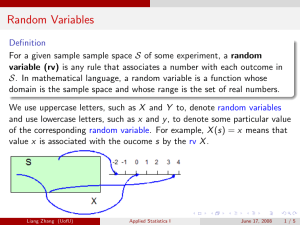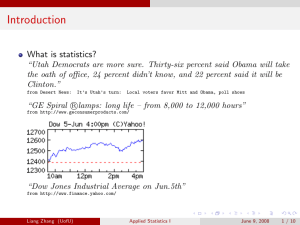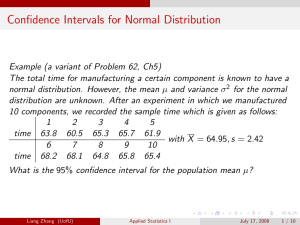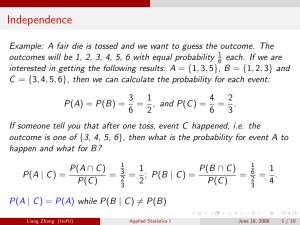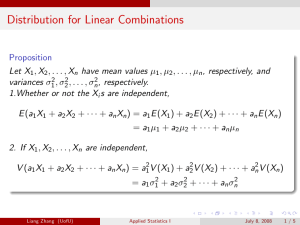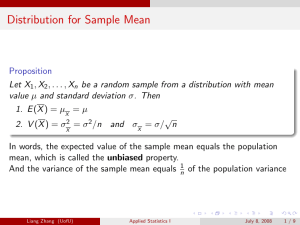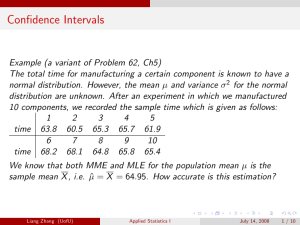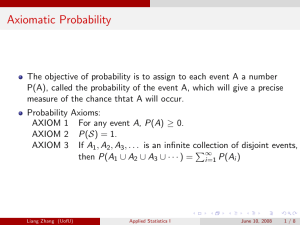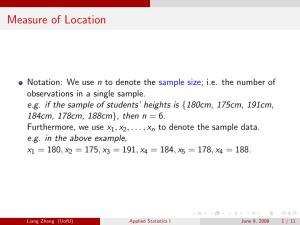Probability Density Functions
advertisement
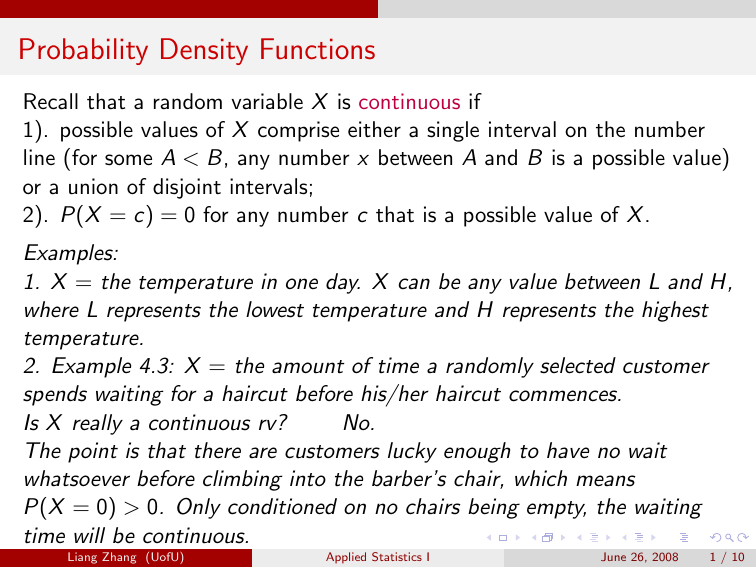
Probability Density Functions Recall that a random variable X is continuous if 1). possible values of X comprise either a single interval on the number line (for some A < B, any number x between A and B is a possible value) or a union of disjoint intervals; 2). P(X = c) = 0 for any number c that is a possible value of X . Examples: 1. X = the temperature in one day. X can be any value between L and H, where L represents the lowest temperature and H represents the highest temperature. 2. Example 4.3: X = the amount of time a randomly selected customer spends waiting for a haircut before his/her haircut commences. Is X really a continuous rv? No. The point is that there are customers lucky enough to have no wait whatsoever before climbing into the barber’s chair, which means P(X = 0) > 0. Only conditioned on no chairs being empty, the waiting time will be continuous. Liang Zhang (UofU) Applied Statistics I June 26, 2008 1 / 10 Probability Density Functions Let’s consider the temperature example again. We want to know the probability that the temperature is in any given interval. For example, what’s the probability for the temperature between 70◦ and 80◦ ? Ultimately, we want to know the probability distribution for X . One way to do that is to record the temperature from time to time and then plot the histogram. However, when you plot the histogram, it’s up to you to choose the bin size. But if we make the bin size finer and finer (meanwhile we need more and more data), the histogram will become a smooth curve which will represent the probability distribution for X . Liang Zhang (UofU) Applied Statistics I June 26, 2008 2 / 10 Probability Density Functions Liang Zhang (UofU) Applied Statistics I June 26, 2008 3 / 10 Probability Density Functions Definition Let X be a continuous rv. Then a probability distribution or probability density function (pdf) of X is a function f (x) such that for any two numbers a and b with a ≤ b, Z b P(a ≤ X ≤ b) = f (x)dx a That is, the probability that X takes on a value in the interval [a, b] is the area above this interval and under the graph of the density function. The graph of f (x) is often referred to as the density curve. Liang Zhang (UofU) Applied Statistics I June 26, 2008 4 / 10 Probability Density Functions Figure: P(60 ≤ X ≤ 70) Liang Zhang (UofU) Applied Statistics I June 26, 2008 5 / 10 Probability Density Functions Remark: For f (x) to be a legitimate pdf, it must satisfy the following two conditions: 1. fR (x) ≥ 0 for all x; ∞ 2. −∞ f (x)dx = area under the entire graph of f (x) = 1. Liang Zhang (UofU) Applied Statistics I June 26, 2008 6 / 10 Probability Density Functions Example: A clock stops at random at any time during the day. Let X be the time (hours plus fractions of hours) at which the clock stops. The pdf for X is known as ( 1 0 ≤ x ≤ 24 f (x) = 24 0 otherwise The density curve for X is showed below: Liang Zhang (UofU) Applied Statistics I June 26, 2008 7 / 10 Probability Density Functions Example: (continued) A clock stops at random at any time during the day. Let X be the time (hours plus fractions of hours) at which the clock stops. The pdf for X is known as ( 1 0 ≤ x ≤ 24 f (x) = 24 0 otherwise If we want to know the probability that the clock will stop between 2:00pm and 2:45pm, then Z 14.75 1 1 1 dx = |14.75 = P(14 ≤ X ≤ 14.75) = 14 24 24 32 14 Liang Zhang (UofU) Applied Statistics I June 26, 2008 8 / 10 Probability Density Functions Definition A continuous rv X is said to have a uniform distribution on the interval [A, B], if the pdf of X is ( 1 A≤x ≤B f (x; A, B) = A−B 0 otherwise The graph of any uniform pdf looks like the graph in the previous example: Liang Zhang (UofU) Applied Statistics I June 26, 2008 9 / 10 Probability Density Functions Comparisons between continuous rv and discrete rv: For discrete rv Y , each possible value is assigned positive probability; For continuous rv X , the probability for any single possible value is 0! Z c Z c+ P(X = c) = f (x)dx = lim f (x)dx = 0 c →0 c− Since P(X = c) = 0 for continuous rv X and P(Y = c 0 ) > 0, we have P(a ≤ X ≤ b) = P(a < X < b) = P(a < X ≤ b) = P(a ≤ X < b) while P(a0 ≤ Y ≤ b 0 ), P(a0 < Y < b 0 ), P(a0 < Y ≤ b 0 ) and P(a0 ≤ Y < b 0 ) are different. Liang Zhang (UofU) Applied Statistics I June 26, 2008 10 / 10
